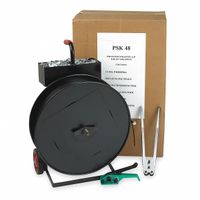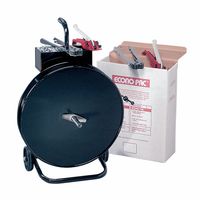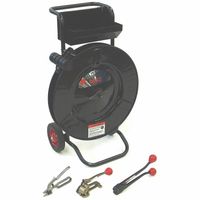Call +(254) 703 030 000 / 751 483 999 / 721 704 777
- Home
- Packaging Shipping
- Strapping
- Strapping Kits
.....Read More
Frequently Asked Questions
What is included in a strapping kit?
A strapping kit typically includes the essential tools and materials needed for securing packages, pallets, or bundles with strapping material. The components of a strapping kit generally include:
1. **Strapping Material**: This is the primary component and can be made of various materials such as polypropylene, polyester, steel, or nylon. The choice of material depends on the weight and type of items being secured.
2. **Strapping Tensioner**: This tool is used to tighten the strapping around the package or pallet. It ensures that the strapping is securely fastened and holds the items in place.
3. **Strapping Sealer**: Also known as a crimper, this tool is used to seal the strapping by crimping a metal seal around the overlapped ends of the strapping. This ensures that the strapping remains tight and secure.
4. **Strapping Seals or Buckles**: These are used to lock the strapping in place. Seals are typically used with a sealer, while buckles can be used for manual strapping without a sealer.
5. **Strapping Dispenser**: This is an optional component but very useful for holding and dispensing the strapping material. It helps in preventing tangles and makes the strapping process more efficient.
6. **Cutting Tool**: A cutter or a pair of shears is included to cut the strapping to the desired length after it has been applied and sealed.
7. **Instructions Manual**: Some kits include a manual or guide to help users understand how to properly use the tools and materials included in the kit.
These components work together to provide a comprehensive solution for securing items for storage or transport.
How do you use a strapping kit?
To use a strapping kit, follow these steps:
1. **Select the Strapping Material**: Choose the appropriate strapping material (polypropylene, polyester, or steel) based on the weight and type of load.
2. **Prepare the Load**: Arrange the items to be strapped on a stable surface or pallet, ensuring they are aligned and compact.
3. **Wrap the Strapping**: Unroll the strapping material and wrap it around the load. For horizontal strapping, pass the strap under the load and bring it over the top. For vertical strapping, wrap it around the sides.
4. **Cut the Strapping**: Use the strapping cutter to cut the strap, leaving enough length to overlap the ends by a few inches.
5. **Thread the Strapping**: Insert one end of the strap through the tensioner tool, then through the buckle or seal. Loop the other end through the buckle or seal, creating a secure loop.
6. **Tension the Strap**: Use the tensioner tool to tighten the strap. Insert the loose end into the tensioner, crank the handle to apply tension, and ensure the load is secure.
7. **Seal the Strap**: If using a buckle, ensure it is properly fastened. For seals, place the seal over the overlapping strap ends and use a sealing tool to crimp and secure it.
8. **Trim Excess Strapping**: Use the cutter to remove any excess strapping beyond the seal or buckle.
9. **Inspect the Strapping**: Check the tension and security of the strap to ensure the load is stable and the strapping is properly applied.
10. **Safety Precautions**: Always wear safety gloves and goggles to protect against sharp edges and tensioned straps.
What types of materials can be used with a strapping kit?
A strapping kit is a versatile tool used for securing and bundling items together, and it can accommodate various types of strapping materials. The most common materials used with a strapping kit include:
1. **Polypropylene (PP) Strapping**: This is a lightweight and economical option, suitable for light to medium-duty applications. It is commonly used for bundling newspapers, cartons, and other lightweight packages.
2. **Polyester (PET) Strapping**: Known for its strength and durability, polyester strapping is ideal for heavy-duty applications. It is often used in industries like construction and shipping for securing heavy loads, as it maintains tension over time and is resistant to UV rays.
3. **Steel Strapping**: This is the strongest type of strapping material, used for securing heavy and rigid loads. Steel strapping is ideal for industrial applications where high tensile strength is required, such as in the metal and lumber industries.
4. **Nylon Strapping**: Although less common, nylon strapping offers high strength and elasticity. It is used in applications where flexibility and shock absorption are important, such as in the transportation of goods that may experience movement.
5. **Corded and Woven Strapping**: These are made from polyester fibers and are used as an alternative to steel strapping. They are lightweight, easy to handle, and do not rust, making them suitable for outdoor applications.
6. **Composite Strapping**: This combines the strength of steel with the flexibility of polyester. It is used for securing heavy loads and is resistant to weather conditions.
Each material has its specific applications, advantages, and limitations, and the choice depends on factors like load weight, environmental conditions, and cost considerations.
How do you choose the right strapping kit for your needs?
To choose the right strapping kit, first assess your specific needs by considering the type and weight of the items you plan to secure. For lightweight packages, polypropylene strapping is suitable, while heavier loads may require polyester or steel strapping for added strength and durability.
Next, determine the strapping width and thickness required based on the load's weight and dimensions. Wider and thicker straps provide more support for heavier items. Consider the environment where the strapping will be used; for outdoor or humid conditions, opt for materials resistant to moisture and UV exposure, like polyester.
Evaluate the tools included in the kit. Manual kits are cost-effective for low-volume applications, while semi-automatic or automatic tools are better for high-volume operations, offering efficiency and consistency. Ensure the kit includes all necessary components, such as tensioners, sealers, and seals or buckles, to avoid additional purchases.
Consider the ease of use and the skill level required to operate the tools. For beginners, user-friendly kits with clear instructions are ideal. Additionally, assess the cost-effectiveness of the kit, balancing initial investment with long-term benefits like durability and reduced labor costs.
Finally, check for compatibility with your existing equipment and processes to ensure seamless integration. Reading reviews and seeking recommendations can provide insights into the reliability and performance of different kits. By carefully evaluating these factors, you can select a strapping kit that meets your specific requirements efficiently and effectively.
What are the benefits of using a strapping kit?
A strapping kit offers several benefits, particularly in packaging and shipping operations. Firstly, it enhances the security of packages by tightly binding items together, reducing the risk of damage during transit. This is crucial for maintaining the integrity of goods, especially in logistics and supply chain management.
Secondly, strapping kits improve efficiency. They streamline the packaging process, allowing for quick and easy application of straps, which saves time and labor costs. This is particularly beneficial in high-volume operations where speed is essential.
Thirdly, they provide versatility. Strapping kits can be used with various materials such as polypropylene, polyester, or steel, making them suitable for different types of loads, from lightweight boxes to heavy pallets. This adaptability ensures that businesses can use the same kit for diverse packaging needs.
Fourthly, strapping kits contribute to cost-effectiveness. By securing loads effectively, they minimize the likelihood of product returns due to damage, thus reducing potential financial losses. Additionally, they often come with reusable tools, which further cuts down on expenses over time.
Fifthly, they enhance safety. Properly strapped packages are less likely to shift or fall during handling and transportation, reducing the risk of injury to workers and damage to goods.
Lastly, strapping kits are user-friendly. They typically include all necessary components, such as tensioners, sealers, and straps, making them accessible even to those with minimal training. This ease of use ensures that businesses can quickly implement strapping solutions without extensive training or setup.
In summary, strapping kits offer security, efficiency, versatility, cost-effectiveness, safety, and user-friendliness, making them an invaluable tool in packaging and shipping operations.
How do you maintain and store a strapping kit?
To maintain and store a strapping kit effectively, follow these steps:
1. **Cleaning**: Regularly clean the tools and equipment in the strapping kit. Use a dry cloth to wipe down metal parts and remove any dust or debris. For more thorough cleaning, use a mild detergent and water, ensuring all parts are completely dry before storage to prevent rust.
2. **Inspection**: Frequently inspect the strapping tools for wear and tear. Check for any signs of damage, such as cracks or bent parts, and ensure that all moving parts function smoothly. Replace any worn or damaged components immediately to maintain efficiency and safety.
3. **Lubrication**: Apply a light machine oil to moving parts such as joints, gears, and cutting mechanisms to ensure smooth operation. Avoid over-lubrication, which can attract dust and debris.
4. **Storage Environment**: Store the strapping kit in a clean, dry, and cool environment to prevent rust and corrosion. Avoid areas with high humidity or direct sunlight. Use a dedicated storage box or cabinet to keep the kit organized and protected from external elements.
5. **Organization**: Keep the strapping tools and accessories organized within the storage space. Use dividers or compartments to separate different tools and materials, making them easy to locate and reducing the risk of damage from clutter.
6. **Inventory Management**: Regularly check the inventory of strapping materials such as seals, buckles, and strapping rolls. Replenish supplies as needed to ensure the kit is always ready for use.
7. **Training and Usage**: Ensure that all users of the strapping kit are properly trained in its use and maintenance. Proper handling and operation can significantly extend the lifespan of the tools and materials.
By following these steps, you can ensure that your strapping kit remains in good condition, ready for efficient and safe use whenever needed.
Where can I buy a strapping kit?
You can purchase a strapping kit from a variety of sources, both online and in physical stores. Here are some options:
1. **Online Retailers**: Websites like Amazon, eBay, and Walmart offer a wide range of strapping kits. These platforms provide customer reviews, competitive pricing, and often fast shipping options.
2. **Industrial Supply Stores**: Companies like Uline, Grainger, and McMaster-Carr specialize in industrial and packaging supplies, including strapping kits. They offer a variety of options suitable for different needs and volumes.
3. **Home Improvement Stores**: Retailers such as Home Depot and Lowe’s carry strapping kits, especially those used for lighter applications. They often have both in-store and online purchasing options.
4. **Specialty Packaging Suppliers**: Businesses that focus on packaging materials, like PackagingSupplies.com or The Packaging Company, offer strapping kits tailored to specific packaging needs.
5. **Local Hardware Stores**: Smaller, local hardware stores may also stock basic strapping kits, especially if they cater to a clientele that includes small businesses or DIY enthusiasts.
6. **Office Supply Stores**: Chains like Staples or Office Depot sometimes carry strapping kits, particularly those used for office or small business shipping needs.
7. **Direct from Manufacturers**: Some manufacturers sell directly to consumers through their websites, offering a range of products and sometimes custom solutions.
When purchasing, consider the type of strapping material (e.g., plastic, steel), the size and weight of the items you need to strap, and whether you need manual or automatic tools. Always compare prices and check for any additional shipping costs or bulk purchase discounts.



